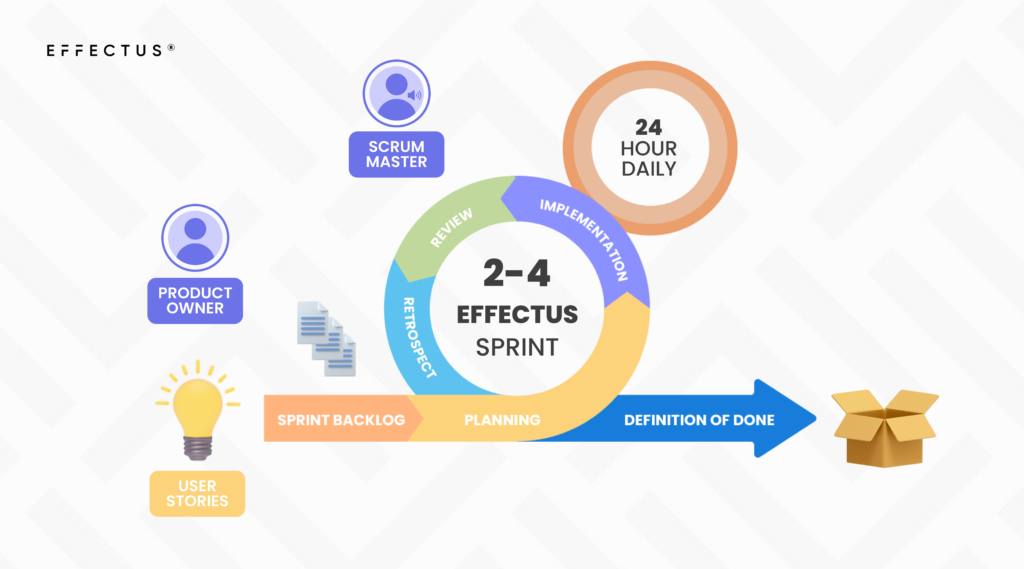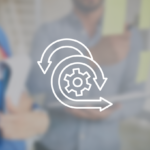5 Software Development Agile Methodologies to Boost Profit
Has the paradigm changed?
It’s high time we knew that these agile methodologies are here to stay. There’s no doubt that not only the processes that we’ve always followed have changed, but also clients and users expectations.
Even though you might think that it’s all about the way we produce… It’s a multifaceted perspective, and needs a deeper analysis to fully understand this paradigm shift.
From a wider perspective, and a shallow perspective we could say that the way we work and organize is always changing, and there’re two ways to analyze it:
- We can do meta-observations in the moment, fully awake.
- We can analyze it as past events.
Clearly, both options work and bring their benefits. So, by looking backwards we could see a movement from systematic processes to more systemic, as well as from vertical or top-down approaches to horizontal ones.
But, why is it relevant to analyze it?
It’s of paramount importance to first look at the name given: Agile, and it’s actually contrasted with Traditional. But, careful there, there’s a glitch in the matrix, it’s not about agile just in terms of production. Its also agile in terms of:
- Communication
- Cooperation
So, you might be wondering: what are agile methodologies? You’ll run into a plethora of posts that cover this, even from our own repertoire. But…
We are going to up the ante; we won’t define, we’ll go straight to the core: boost in profit.
There’s a common belief that agile means faster, but it’s actually not about that. Albeit, it’s one of the consequences of the process that should be followed. These methodologies advocate the idea that a constant communication is adamant.
A high-frequency iteration allows different stakeholders and members of the team to co-regulate and understand among themselves better. And, we need to reinforce the idea that horizontally, we are all part of it: PO, PM, Devs, SM, etc.
They not only prioritize communication and horizontality but also embrace adaptability and flexibility. They encourage teams to embrace change and iterate on their work continuously.
By breaking down complex projects into smaller, manageable tasks, agile methodologies allow for incremental progress and regular feedback. Profit is about product and learning, then!
This iterative approach also enables teams to respond quickly to evolving requirements, market demands, and customer feedback, ultimately delivering high-quality results.
With its emphasis on effective communication, collaboration, and adaptability, they have become increasingly popular in today’s fast-paced and ever-changing business landscape.
By adopting agile practices, teams can enhance productivity, reduce risk, and ultimately achieve greater success in their projects. Plus, enhance the learning curve projects have.
Contact our top-notch team of professionals
Most popular agile methodologies nowadays
We’ll go over them, but first here you can find a quick overview to recall what they are.
There’re some frameworks that have become renowned in the past years. If you had to categorize them, we’d suggest you check their characteristics to find whatever suits best. You could sort it:
- Chronologically
- Frequency of use
- Industry
- Affinity
- Time
- Learning curve
Even though you can stick to one framework, remember you can always navigate though them finding the perfect fit for your project, shifting and making the needed adaptations you need to meet expectations.
Scrum
In today’s fast-paced business landscape, teams are constantly seeking ways to maximize their productivity. Enter the Scrum framework, a game-changer in project management.
Vogue methodology? You bet! Here we provide you with a visual aid to facilitate the understanding of it. Special thanks to our top-notch designer Soledad Perez.

So, let’s get started. First of all, we need to understand the roles that take part in the process. We can find: product owner, scrum master, and a team of devs [including designers and developers]. These are the core of it.
Unleash Your Team’s Potential: Mastering Key Roles
Imagine a world where everyone on your team knows their role, works in harmony, and delivers outstanding results. That’s precisely what the Scrum framework brings to the table.
Scrum operates on the principle of defined roles, each with a specific purpose and contribution to the team’s success.
The Product Owner, the mastermind behind product vision, collaborates with stakeholders, sets priorities, and ensures the team is building what truly matters.
The Scrum Master, the ultimate facilitator, guides the team in embracing agile practices, removing obstacles, and fostering a culture of continuous improvement.
And then there are the Development Team members, the superheroes who bring ideas to life, collaborating closely and self-organizing to deliver remarkable solutions.
With Scrum’s emphasis on clear roles and collaboration, your team can tap into its full potential, achieving unprecedented heights of innovation, efficiency, and satisfaction.
Unlock Your Team’s Productivity: Mastering Sprints
At the heart of Scrum lies the concept of sprints – short, time-boxed iterations that fuel efficiency and drive results.
By breaking down complex projects into manageable chunks, teams can focus their efforts on specific deliverables, empowering them to achieve goals with lightning speed.
Each sprint, typically lasting one to two weeks [tops 4], is a race against time, propelling teams forward and ensuring constant progress.
With Scrum’s sprint-driven approach, your team can harness the power of focus, collaboration, and measurable outcomes, taking your productivity to unprecedented levels.
Kanban
Boost Your Team’s Efficiency: Visual Management
In today’s fast-paced work environment, staying organized and efficient is paramount. That’s where the Kanban method comes in, revolutionizing the way teams manage their workflow.
At the core of Kanban lies visual management – a visual representation of tasks, progress, and bottlenecks. Imagine a colorful, dynamic board that provides a real-time snapshot of your team’s work.
With Kanban, you can effortlessly track tasks, identify potential blockers, and optimize your flow. No more guessing games or scattered information.
It’s all laid out before your eyes, enabling your team to streamline processes and achieve remarkable efficiency.
Master the Art of Continuous Flow: Key Roles
What if you could achieve a steady, uninterrupted flow of work? Enter the Kanban method, a game-changer in achieving continuous flow and minimizing waste.
Kanban breaks away from traditional project management by focusing on a pull-based system. Instead of overwhelming your team with an excessive workload, Kanban empowers them to take on tasks as capacity allows.
With clearly defined work-in-progress (WIP) limits, your team can maintain a balanced workflow, avoiding bottlenecks and ensuring optimal productivity.
The roles in Kanban are equally crucial:
- Team, responsible for executing tasks and collaborating seamlessly
- Kanban Master, the driving force behind the method’s implementation and optimization
- Customer, providing feedback and driving value
By mastering the art of continuous flow and leveraging the power of Kanban, your team can unlock new levels of efficiency, customer satisfaction, and overall success.
Lean
Embrace Lean Methodology and Crush Inefficiencies
Lean is all about eliminating waste and maximizing value.
By identifying and eliminating non-value-added activities, Lean helps you streamline your operations, delivering products and services faster and with higher quality.
From minimizing inventory and reducing unnecessary movement to optimizing information flow and fostering a culture of continuous improvement, Lean unlocks your team’s potential for excellence.
Unleash the Lean Revolution: Principles, Kaizen, and Unbeatable Benefits
Revolutionize your organization’s performance. Lean operates on a set of powerful principles designed to optimize efficiency and value creation.
By relentlessly pursuing waste reduction, Lean empowers you to identify and eliminate activities that don’t add value to your processes.
This relentless pursuit of efficiency is complemented by the concept of Kaizen. With Kaizen, every team member becomes an agent of positive change, constantly seeking ways to enhance processes, reduce waste, and improve quality.
The benefits of Lean are undeniable:
- increased productivity
- reduced costs
- improved customer satisfaction
- culture of continuous improvement that fuels success.
So, feeling like unleashing the power of Lean and embarking on a transformative journey towards excellence?
XP
Are you ready to revolutionize your software development process and deliver outstanding results? Look no further than Extreme Programming (XP), a groundbreaking approach that transforms how teams build software.
XP is all about pushing the boundaries of innovation, collaboration, and quality. With its emphasis on customer satisfaction, feedback, and adaptability, XP ensures that your team delivers precisely what users need.
By breaking down complex projects into manageable increments, XP allows for frequent releases pair programming; brings together the power of two minds, enhancing code quality and knowledge sharing.
And with practices like test-driven development (TDD) and continuous integration (CI), you can bid farewell to the nightmare of bugs and ensure a smooth, error-free development journey.
Roles, Practices, and Unbeatable Benefits
XP thrives on collaboration, with key roles that make the magic happen. The Customer, your invaluable guide, provides feedback, sets priorities, and ensures that the software aligns with user needs.
The Developer, the mastermind behind the code, embraces practices like pair programming, TDD, and CI to create robust, bug-free solutions.
The Coach, the mentor who champions XP principles, helps your team embrace the XP mindset and continuously improve their skills.
Together, this dream team creates software that’s user-centric, high-quality, and adaptable to change. With XP, you’ll experience unparalleled benefits:
- reduced defects
- faster time-to-market
- improved team communication
- delighted customers
So, are you ready to supercharge your software development and embark on an XP adventure?
What follows? The impossible to forget, not agile… Waterfall methodology!
Waterfall
Let’s compare – Agile vs. Waterfall Methodologies
In the realm of software development, the battle between agile methodologies (such as Scrum and Kanban) and traditional waterfall methodologies has been raging for years.
Waterfall methodologies follow a linear, sequential approach, where each phase must be completed before moving to the next. This rigid structure can lead to delays, as changes are difficult to accommodate once the project is underway.
Agile, on the other hand, offer a refreshing alternative. They embrace flexibility, adaptability, and collaboration, enabling teams to respond quickly to change and deliver incremental value.
With their iterative approach, AMs break projects into manageable sprints or iterations, allowing for continuous feedback and adjustments.
This nimble and customer-focused approach sets AMs apart, freeing teams from the shackles of the waterfall’s constraints.
The Rise of Agile: Outpacing Waterfall in Today’s Dynamic Landscape
In today’s fast-paced and rapidly evolving business landscape, the shortcomings of traditional waterfall methodologies have become increasingly evident.
Waterfall methodologies rely on extensive planning upfront and require accurate prediction of future requirements, which is often challenging in dynamic environments. On the other hand, Scrum and Kanban, thrive in such uncertainty.
By emphasizing adaptability, collaboration, and continuous improvement, AMs enable teams to respond swiftly to changing customer needs and market demands.
Agile methodologies promote incremental progress, iterative feedback, and the ability to pivot when necessary, providing organizations with a competitive edge in the face of constant change.
As a result, the rise of AMs has redefined the software development landscape, leaving waterfall methodologies struggling to keep up.
But, Benefits of Waterfall Methodology: Embracing Stability and Predictability: The Benefits of Waterfall Methodology.
While agile methodologies have gained significant popularity, it’s important to acknowledge the benefits of the waterfall methodology in certain contexts.
Waterfall offers a structured and predictable approach, suitable for projects with well-defined requirements and stable environments.
Its sequential nature provides a clear roadmap, allowing for comprehensive planning, documentation, and accountability. Waterfall is especially advantageous when there is little room for change or when regulatory compliance is critical.
In industries where risk mitigation and predictability are paramount, such as construction or manufacturing, the waterfall methodology can offer stability and ensure adherence to strict standards.
By following a linear path and focusing on thorough upfront planning, waterfall methodology provides a tried-and-tested approach that continues to serve industries with specific requirements.
Is there a real impact in the workforce experience?
- Communication: prioritize open and frequent communication among team members. This leads to improved collaboration, shared understanding, and increased transparency.
Regular meetings, such as daily stand-ups and sprint reviews, provide opportunities for team members to exchange information, share progress, discuss challenges, and align their efforts.
This enhanced communication fosters a more cohesive and collaborative work environment, where ideas and feedback flow more freely, leading to better decision-making and problem-solving.
- Time-frame: characterized by their iterative and time-boxed approach.
By breaking down projects into manageable increments, such as sprints, teams are better able to plan and estimate their work.
This allows for more realistic and achievable timeframes, as the focus is on delivering small, valuable increments within shorter timeframes.
This sense of rhythm and cadence helps manage expectations and reduces the risk of prolonged or unpredictable timelines.
The time-boxed nature of agile also facilitates regular feedback and adaptation, ensuring that teams stay on track and adjust their plans as needed.
- Sense of achievement: provide a sense of achievement through their incremental delivery approach.
As teams work on and complete smaller iterations or user stories, they experience a continuous sense of progress and accomplishment.
This incremental delivery fosters a positive feedback loop, as each successful iteration or increment reinforces the team’s motivation and confidence.
Celebrating these small wins along the way contributes to a sense of achievement and boosts team morale, making the work experience more fulfilling and rewarding.
- Learning curve: promote a culture of continuous learning and improvement.
Through retrospectives and feedback loops, teams regularly reflect on their performance, identify areas for growth, and implement changes for the next iteration.
This focus on reflection and adaptation helps teams embrace a learning mindset and encourages personal and professional development.
The iterative nature of agile methodologies also allows for faster feedback and course correction, enabling teams to learn from their mistakes and make adjustments early on, ultimately reducing risks and improving overall performance.
- Collaboration: emphasize collaboration among team members.
By fostering cross-functional teams and encouraging collective ownership of deliverables, agile methodologies break down silos and promote a collaborative work culture.
Team members work together, share knowledge, and contribute their expertise to achieve shared goals. This collaborative environment leads to improved problem-solving, increased creativity, and higher-quality outcomes.
Agile methodologies also provide opportunities for shared decision-making and collaboration with stakeholders, enhancing engagement and fostering a sense of shared responsibility.
Overall, agile methodologies have a significant impact on the workforce experience by promoting effective communication, realistic time-frames, a sense of achievement, continuous learning, and collaborative teamwork.
Clients’ dream
Participation: actively involve clients throughout the project lifecycle. Clients are not mere spectators; they play an integral role in shaping the outcome.
Through regular meetings, collaboration, and feedback sessions, clients can actively participate in decision-making, prioritize features, and provide input on the evolving product.
This level of client involvement ensures that the final deliverable aligns with their expectations, needs, and goals.
On top of the process: place the client at the center of the development process. Rather than being isolated from the project until the final delivery, clients are consistently engaged and informed about the progress.
They have visibility into the development iterations, including the features being implemented and the overall timeline.
This transparency allows clients to stay informed, make informed decisions, and have real-time visibility into the project’s status.
Clients have the opportunity to provide continuous feedback, address any concerns promptly, and make adjustments as needed, ensuring a product that meets their requirements.
Increments: focus on delivering working increments of the product in short iterations. Instead of waiting until the end of the project to see tangible results, clients receive tangible value at the end of each iteration.
This iterative approach allows clients to see progress, validate functionality, and provide feedback early on.
They can make adjustments or change priorities based on the delivered increments, ensuring that the final product meets their evolving needs.
This incremental delivery also reduces the risk of investing in a product that doesn’t align with client expectations, as regular feedback and adjustments are incorporated throughout the development process.
By emphasizing participation, keeping clients on top of the process, and delivering increments, agile methodologies foster a collaborative and client-centric approach.
Clients have the opportunity to actively contribute, stay informed, and receive tangible value throughout the project, ultimately leading to higher client satisfaction, better alignment with their goals, and a final product that meets their evolving needs.
It’s all about the communicative effect
It is within this logic of questioning that Communication is brought in as a discipline, to provide a perspective on its cross-sectional and longitudinal aspects in all processes.
This discipline will be understood as “Educational and Community Communication… as ‘the other communication’: a professional, academic, disciplinary, and social practice field that promotes research, the construction of knowledge, and the production of educational processes, drawing upon long-standing Latin American traditions” (Kaplún, 2007:311).
It is worth noting that this approach is framed within a constructivist communicability paradigm that “does not propose a body of knowledge that is transported and applied to new contexts, but rather being part of processes of participation and collective construction” (Acosta et al., 2011:408).
On the one hand, the challenges lie in the point of contact among teams and the other actors; on the other hand, in the recursive transit and movement of agile processes that encompass the involved areas of knowledge.
It is necessary to highlight that the difficulties that arise are not explicit or inherently problematic, but rather known, so it is proposed from the beginning to use communication for a strategically facilitative design that enables an organic process.
To address aspects related to knowledge, from its applicability to its construction and methodology, the concept of communication and critical thinking is understood as a starting point:
“is not the heritage of intellectuals, nor is it just a ‘trend,’ but rather a permanent construction by all those involved in the daily processes of transforming their realities” (Acosta et al., 2011:407).
Therefore, communication will be an “instrument and method” to promote diverse participation in the processes of transformation and knowledge generation.
Communication, therefore, not only accompanies processes in a longitudinal and cross-sectional dimension but also does so with three approaches: outward, inward, and with a mechanism of transformation.
It must be kept in mind that its nature is transformative and participatory, so the aim is not to apply “protocols” but to construct together.
We can also observe that moments of internal communication occur throughout the process, being fertile ground for building communicability.
Internal communication is not top-down and inward-directed but requires a recursive process, effective feedback that sharpens the understanding of the codes handled by different actors, in logical, linguistic, and methodological terms.




Leave a Reply
You must be logged in to post a comment.